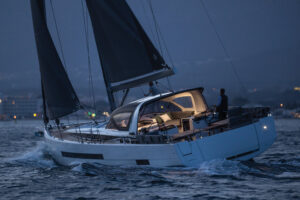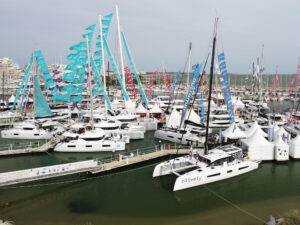During and in the four days immediately following the US Sailboat show in Annapolis, Maryland, the Cruising World judges inspected and sailed on 27 boats vying for recognition. Learn more about the boats in our 2022 Boat of the Year »
After a year in which boat shows and sail tests were upended in these pandemic times, an impressive fleet of 27 new monohulls and catamarans gathered on Chesapeake Bay for the 2022 Boat of the Year competition. It was the largest fleet in many years, and in absolutely stellar conditions, our team of independent judges put the gleaming new yachts through their paces. When the spray had settled, eight winners were crowned in size- and purpose-related categories, and another pair of superb craft were recognized for their overall excellence. Were there surprises? Oh, yes. The following pages tell the whole tale.
Nobody knew what to expect. The only sure thing was that a year after the US Sailboat Show in Annapolis, Maryland, went on hiatus due to the persistent pandemic, the gates would again open in October 2021, and the show would go on. But would eager sailors flock to the downtown docks to see the latest offerings from sailboat manufacturers near and far? And for that matter, would the docks themselves be packed with new boats? Furthermore, by extension, how many of those new models would be eligible and nominated for the 2022 Boat of the Year competition?
With those questions still hanging, on October 14, the gates in Maryland’s capital city indeed swung open. And all the answers were immediately forthcoming.
Record-setting crowds descended on the Annapolis City Dock starting from the show’s opening moments on what is usually a rather subdued first day. By that Thursday afternoon, the numbers had swelled to proportions usually reserved for the Saturday throng to be expected on a perfect Chesapeake Bay fall weekend. And many an attendee came with checkbook in hand, as manufacturers gleefully reported dozens of sales and order books full for 2022…and for some, years beyond.
Meanwhile, the Boat of the Year’s three-man independent judging panel got to work. Like the show’s vendors, they had their hands full.
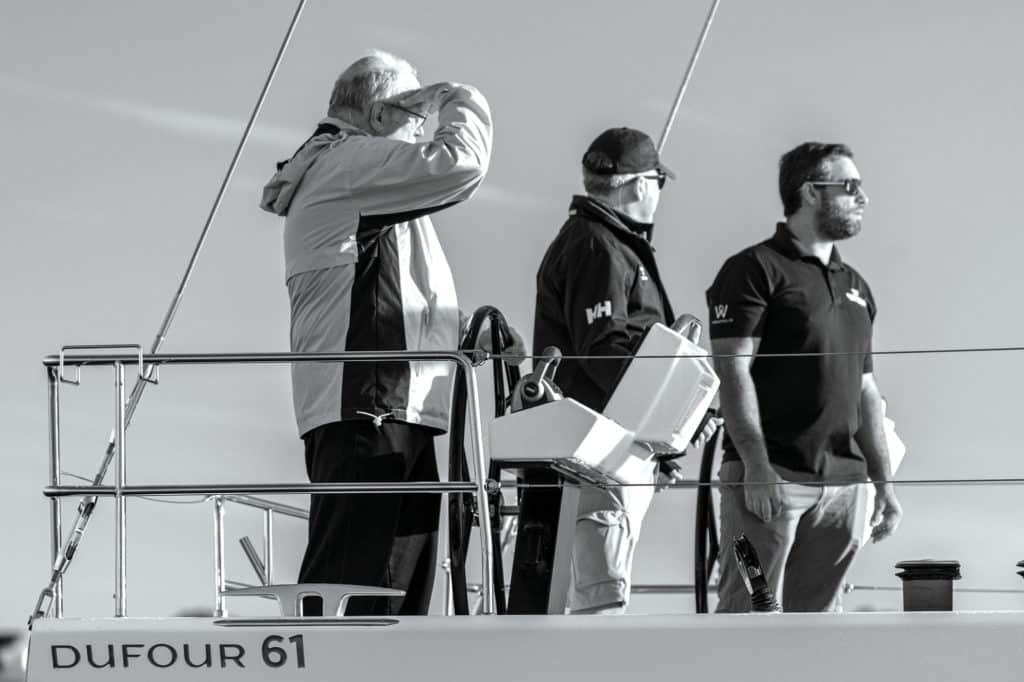
Because last year’s BOTY contest was conducted in unusual conditions (see “The Determined Dozen: BOTY 2021,” January 2021) and with a reduced entry list, several nominees that weren’t available in 2021 were automatically rolled over into the 2022 fleet. And what a roster it was. The 27 entries—the largest BOTY entry list in many years—were ultimately broken down into eight categories, with the 16 monohulls distributed over five divisions ranging from 24 feet to 67 feet in size, and with prices ranging from $50,000 to $4 million. Meanwhile, the 11 nominated catamarans were grouped in three classes: two based on size and a third focused on performance. And talk about an international gathering! Builders from no fewer than nine nations were represented: the US, France, Germany, Holland, Italy, Slovenia, South Africa, Sweden and Taiwan. The only thing missing? Most of the respective company’s builders, naval architects and salesmen, all sidelined by COVID-19-related travel restrictions to the States.
Their absence did not prevent the judging panel from rolling up their sleeves and getting to work.
As always, the contest was divided into two parts: onboard inspections that took place on the docks during the show, and at-sea sail trials conducted in the days immediately following the boat show. Chesapeake Bay can, and often does, serve up a variety of conditions for early-fall sail tests—everything from flat calms to small gales—but in 2021, the weather was simply spectacular, and almost every nominee got a chance to strut its stuff in the breeze and sunshine that it deserved. Which was and is always important; sometimes a boat that doesn’t shine at the dock lights up the panelists once its sails are hoisted and sheeted in, and its true capabilities and objectives are revealed.
When all was said and done, the judges chose winners in eight separate size- and/or purpose-related categories. Just for good measure—because they were suitably impressed by their excellence—they also presented a pair of separate awards to boats that deserved special recognition.
Every year, each category winner is eligible for the major prize: the overall Boat of the Year. And of course, as always, one boat distinguished itself above and beyond all others: For 2022, it was the Hylas H57.
2022 Boat of the Year Overall Winner
From the Far East to the Far Horizons: The Hylas H57
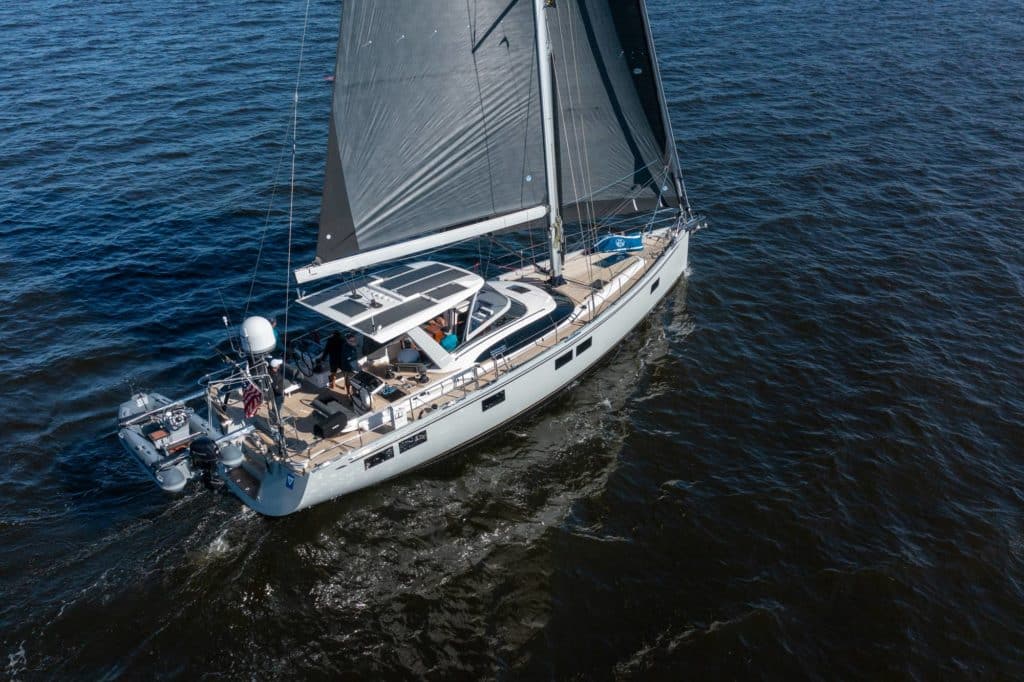
For Cruising World readers, there’s something to be said for boats that not only live up to their stated design purpose and objective, but which are also aspirational, something that could deliver them to the far horizons of their sailing dreams. For 2022, as judging deliberations unfolded, several candidates were in the mix for the title of Overall Boat of the Year. But the conversation kept coming back to one boat in particular, and ultimately, it rose to the top of the peak. That boat is the Hylas H57. Here’s what the judges had to say about it, and why it ultimately earned their vote.
Tim Murphy: This Bill Dixon design is a departure from previous Germán Frers-designed Hylas yachts. It signals a new trend: new look, new layout, new thinking. This is a 57-foot twin-rudder boat that displaces 57,000 pounds. They’re doing something that we’ve seen in a lot of new boats lately, a trend where there’s a separation between the social cockpit and the working cockpit, and well aft, a walkway down between the twin helms to the transom. It’s a good solution. It works.
“When you come alongside, it actually looks and feels a little like a catamaran. It’s got a hard dodger built in, a very successful one, which I think is quite useful when you’re in the cockpit. Everyone wants to have shade and shelter from rain and the elements, and this is an excellent answer for that. By and large, this is just a very nice, functional cruising boat. The berths are big and luxurious, but they’re also set up for lee cloths. This is a boat meant to go places. And it’s lovely to be aboard. It’s just a very strong boat in many, many ways.”
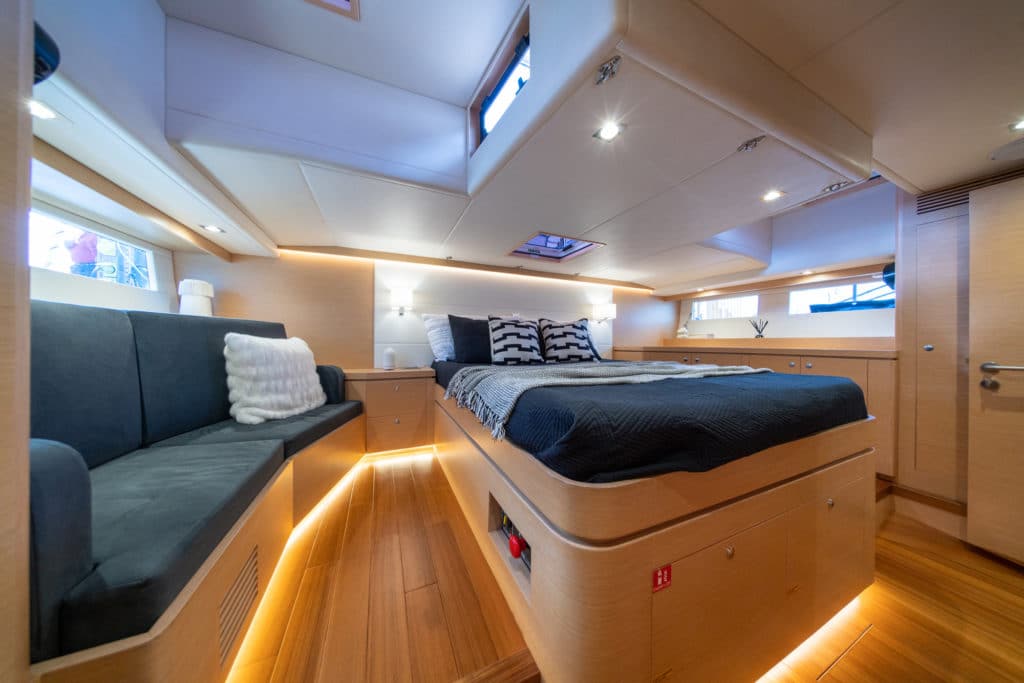
Ed Sherman: “The boat we sailed seemed like a test bed for systems the company is considering for future models. The owners have broad experience in offshore sailing and considered very carefully what they wanted in a large boat that can be easily sailed by a cruising couple. From the custom enclosure for the helm and cockpit area to the powered winches and video-camera repeaters at the helm station to confirm sail trim, I think they hit a home run.
“Like other boats we tested in this size range, the builder employed a 24-volt DC electrical system, which dramatically reduces overall weight on a boat as systems-rich as this was. Additionally, the electrical-system design helped ensure that onboard systems would function regardless of global location: 120-volt/60 Hz or 230-volt/50 Hz, it didn’t matter; accommodation was made to cover all bases.
“On top of all that, it sailed well. I thought they did a great job in designing the sailhandling controls. It’s all right there near the helm, and it worked well. I liked that. It got my vote.”
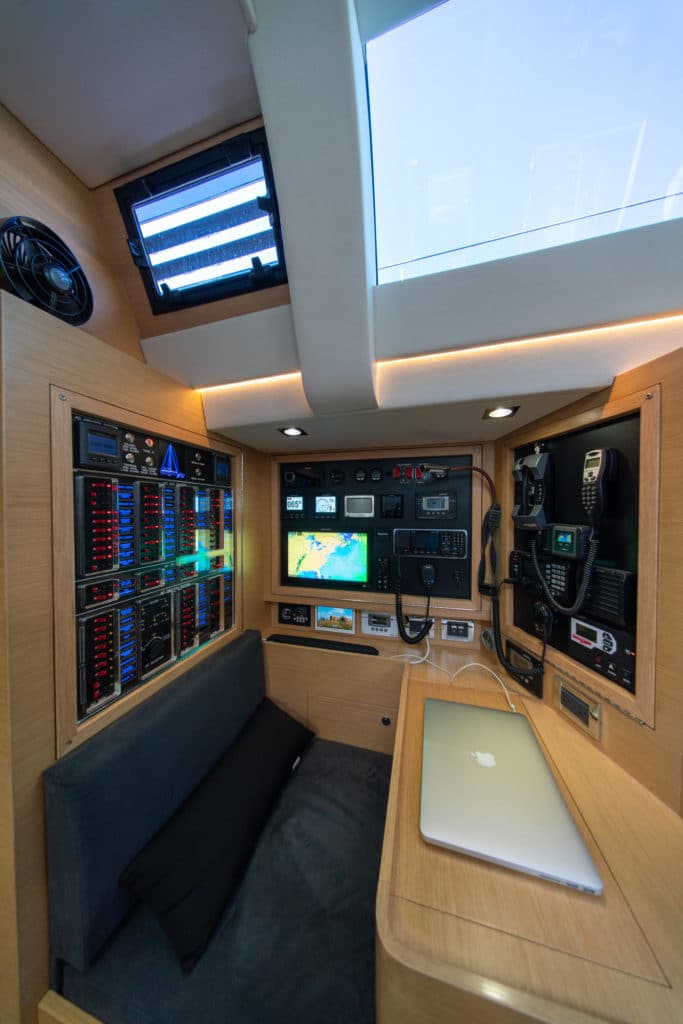
Gerry Douglas: “The performance of the boat was terrific. It tacked through about 50 degrees, which was outstanding for a boat that big. It was always sailing at about 60 percent of the windspeed, which for a big, heavy boat like that was impressive. Regarding the boat’s ergonomics, every place to sit was comfortable. You had good seatback support and nothing awkward to step over. All the companionway steps were of equal size and worked well. It was just a really easy boat to get around. All the seat dimensions in the interior were correct. We’ve seen so many boats where that’s not the case. It was really comfortable to sit in. And you can imagine sitting there reading a book for hours and not feeling like you’re sitting on a park bench.
“I voted for the Hylas because I think it was probably the most different from any other previous boat that the company has produced. It’s the first one that appealed to me personally. It is a little challenging aesthetically on the outside, but I think maybe that’s just my own personal aesthetic. But there’s a lot of content there and the price point—in retrospect, in view of all the prices of the boats in this year’s contest—is pretty reasonable. I never thought I’d say that a boat worth 2 million bucks was reasonable, but it is.”
You know what else is reasonable? That the H57 will take its owners wherever they wish with style and panache.
The Boat of the Year Judges
Before his recent retirement, BOTY judge Gerry Douglas spent most of his 45 years in the marine industry as the chief engineer, designer and vice president at Catalina Yachts, where he also oversaw all phases of manufacturing at the Florida yard. His designs account for more than 40,000 hulls produced under the Catalina, Capri and Morgan Marine brands. Among them, 13 models have won BOTY awards.
CW editor-at-large Tim Murphy has tested and written about hundreds of sailboats during his many years as a BOTY judge. He grew up living aboard a 41-foot ketch and sailing along the US East Coast and the Bahamas before earning a 100-ton US Coast Guard license. His career has included stints as a sailing instructor, as well as a writer and editor for a number of publications and organizations, including the American Boat and Yacht Council. Immediately after this year’s BOTY contest, Murphy set sail on his recently refitted Passport 40, Billy Pilgrim, bound for the grand unknown.
Longtime CW contributing technical writer and BOTY judge Ed Sherman recently retired from full-time service with the ABYC, where he was the education vice president. During his career, Sherman has written numerous books, including Advanced Marine Electrics and Electronics Troubleshooting, and he has developed courseware for programs at the New England Institute of Technology and International Yacht Restoration School, as well as for the US Navy, Coast Guard and NOAA. As a BOTY judge, he’s frequently spotted, screwdriver in hand, digging deep into electrical panels and engine rooms.
Sailing (and Judging) by the Numbers
Besides the usual numbers used to describe a sailboat—length, beam, draft and sail area—CW’s Boat of the Year judges sometimes rely on sail area/displacement and displacement/length ratios, as well as decibels for sound while motoring, to compare similar vessels (see specs, pages 64-65). One caveat, because sailboat design and building materials change over time: Design ratios work best when looking at boats of a similar era rather than comparing, say, a 1975 cruiser to its modern counterpart.
Let’s start with displacement/length. Displacement is a measure of how much water a particular hull form displaces, and length is, well, length. In general terms, the lower the D/L ratio is, the less water is being displaced for a given length, which would indicate better performance. Performance, though, often reflects speed but not necessarily comfort underway. Long-distance cruisers might get there fast on a boat with a very low D/L figure, but they might not get much sleep along the way because of the boat’s lively movement in a seaway.
Sail area/displacement is a ratio that reflects how much horsepower a particular sail plan has to push a vessel. Most cruising boats today will have an SA/D number in the high teens and low 20s, with the higher the ratio indicating a more powerful rig. Again, the numbers can deceive. The trend today is toward sail plans with nonoverlapping jibs. Boats sail just fine upwind, but the minute you bear away, the relatively small jib quickly becomes ineffective. To counter this, sprits have been added to fly off-wind sails, such as code zeros and cruising spinnakers.
Lastly, our BOTY judges measure the sound, or decibel levels, aboard every boat when motoring. Why? First, it’s hard to sleep on a loud boat, and if the crew can’t stay rested, it can lead to all sorts of other problems. Second, silence doesn’t come cheap. Besides a lack of proper sound insulation, rattles and creaks caused by poor construction can all contribute to the din. To put things in perspective, 50 dB is equivalent to a quiet conversation at home, and 60 dB is akin to background music at a restaurant. Noise in the upper 70 dB range can be considered annoying; above 80 dB, noise can become harmful after long exposure.

